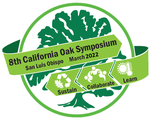#30

Nest-site relationships among cavity-nesting birds of oak woodlands in California: identifying the source of cavities for nonexcavators
Kathryn Purcell, USDA Forest Service, Pacific Southwest Research Station
We explored differences and similarities in nest sites among and within cavity-nesting bird species that excavate their own cavities and those that use pre-existing cavities, predicted the source of excavated cavities used by nonexcavators, and explored the potential for nest-site competition between European Starlings (Sturnus vulgaris) and native cavity nesters. We modeled differences in cavities excavated by Acorn Woodpeckers (Melanerpes formicivorus) and Nuttall’s Woodpeckers (Picoides nuttallii) and predicted use by seven nonexcavator species. Acorn Woodpecker cavities were deeper, had longer entrances and larger entrance holes, and were more often in blue oaks (Quercus douglasii). Nuttall’s Woodpecker cavities tended to face more downward. European Starlings used mainly Acorn Woodpecker-excavated cavities, while nests of Ash-throated Flycatchers (Myiarchus cinerascens), Oak Titmice (Baeolophus inornatus), House Wrens (Troglodytes aedon), and Western Bluebirds (Sialia mexicana) were classified more often as Nuttall’s Woodpecker cavities. Cavities used by European Starlings were similar to those of Western Bluebirds, Violet-green Swallows (Tachycineta thalassina), and, to a lesser extent, White-breasted Nuthatches (Sitta carolinensis). Data on phenology showed that nest initiation dates of European Starlings overlapped extensively with those of Acorn Woodpeckers, White-breasted Nuthatches, and Oak Titmice. Results also suggested avoidance of peak nesting dates of starlings by Acorn Woodpeckers and Western Bluebirds. Nests of Acorn Woodpeckers, Western Bluebirds, and Violet-green Swallows had northern orientations, which is likely an adaptation for avoiding heat stress. Nest sites used by Ash-throated Flycatchers were not optimal for reproductive success, but those used by European Starlings appeared to be. The impact of European Starlings on native cavity-nesting species is potentially significant for Acorn Woodpeckers, Western Bluebirds, Violet-green Swallows, and possibly White-breasted Nuthatches when nest sites are limiting. Acorn and Nuttall’s woodpeckers are keystone species in this bird community, calling for long-term monitoring of population trends and management strategies that aid in enhancing the populations of these two species.
